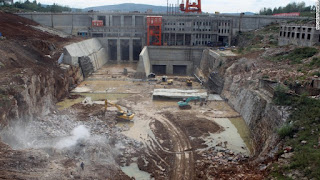Study Discovers Climate Assumes Role in Decay of One of Asia's Most Basic Water Assets
Study discovers atmosphere assumes part in decay of one of Asia's most basic water assets
MANHATTAN — Climate fluctuation — as opposed to the nearness of a noteworthy dam — is in all probability the essential driver for a water supply decrease in East Asia's biggest floodplain lake framework, as indicated by a Kansas State University specialist.
The fluvial lake framework over China's Yangtze River Plain, which serves almost a large portion of a billion people and is a World Wildlife Fund ecoregion, lost around 10 percent of its water territory from 2000-2011, as indicated by Jida Wang, colleague educator of topography. Wang and associates distributed their discoveries for the lake framework's decrease in the American Geophysical Union's diary Water Resources Research.
"Many individuals' first instinct is that the offender must be the Three Gorges Dam since it appropriates such a great amount of water in the Yangtze River, yet our fingerprinting study irrefutably demonstrates that the dam is not the decay's essential driver," Wang said. "Atmosphere fluctuation is the dominating driver of this decadal dynamic."
Wang teamed up with Yongwei Sheng, of the University of California, Los Angeles, and Yoshihide Wada, of Austria's International Institute for Applied Systems Analysis. They found that around 80 percent of the watched lake decrease is the aftereffect of synchronous atmosphere inconstancy firmly identified with the El Niño-Southern Oscillation, which has caused dry seasons and flooding in the locale.
"Our discoveries don't mean the Three Gorges Dam has no effect on the downstream lake framework, yet the fundamental effect hitherto has been constrained to the adjustment of the lakes' regular example, as opposed to an interannual decrease," Wang said. "The regular effect is especially clear when the supply stores water each tumble to get ready for control era. This brings down the downstream Yangtze River level and depletes some portion of the water spending plan in the associated lakes.
"Like most supplies, the Three Gorges Dam traps dregs in its store, which causes disintegration downstream," he said. "Be that as it may, on the positive side, it discharges extra water in drier seasons, for example, winter and spring. By and large, the dam's effect is substantially littler than that of the atmosphere framework, at any rate in the examined decade."
The dam is the world's biggest hydroelectric venture. Its development, which began in late 1994, and store water impoundment after mid-2003 removed a large number of individuals from thousand-year-old towns upstream and caused real social dispute, Wang said.
The dispute is not just restricted to the upstream district, Wang said. The supply has put away 40 gigatons of water since 2003, constraining the measure of normal water stream nourishing to the downstream Yangtze River Plain, which is home to a great many freshwater lakes and crucial to China's economy.
"This procedure, intriguingly, matched with the watched lake decay and a few extraordinary dry spells over the Yangtze River Plain," Wang said.
Wang and his partners likewise evaluated the negative effects of human water utilization from agrarian, mechanical and local segments over the downstream Yangtze River Basin. These effects are shockingly practically identical to the Three Gorges Dam's effect, Wang said. The dam and human water utilization together involve 10-20 percent — or less — of the decay's elements, while up to another 10 percent of the decrease might be caused by an assortment of different elements, perhaps including different dams, sand mining, soil preservation and urbanization, he said.
"It additionally is imperative to perceive that anthropogenic effects have fortified in the recent decades," Wang said. "Despite the fact that the Three Gorges Dam as of now achieved its maximal stockpiling limit in 2010, its actuated Yangtze River disintegration will proceed. This likewise may join expanding human water utilization and trans-bowl redirections. We trust our examination not just gives a late clarification of the past decadal lake decrease yet in addition offers logical direction for future protection of this basic new water asset."
For their examination, Wang and his associates utilized a huge number of satellite pictures from NASA, a progressed hydrological show from the Netherlands, factual information from the United Nations, and estimations and censuses from a few Chinese associations.
This examination was subsidized by the U.S. Topographical Survey's Landsat Science Team and a Kansas State University workforce start-up subsidize.


Comments
Post a Comment